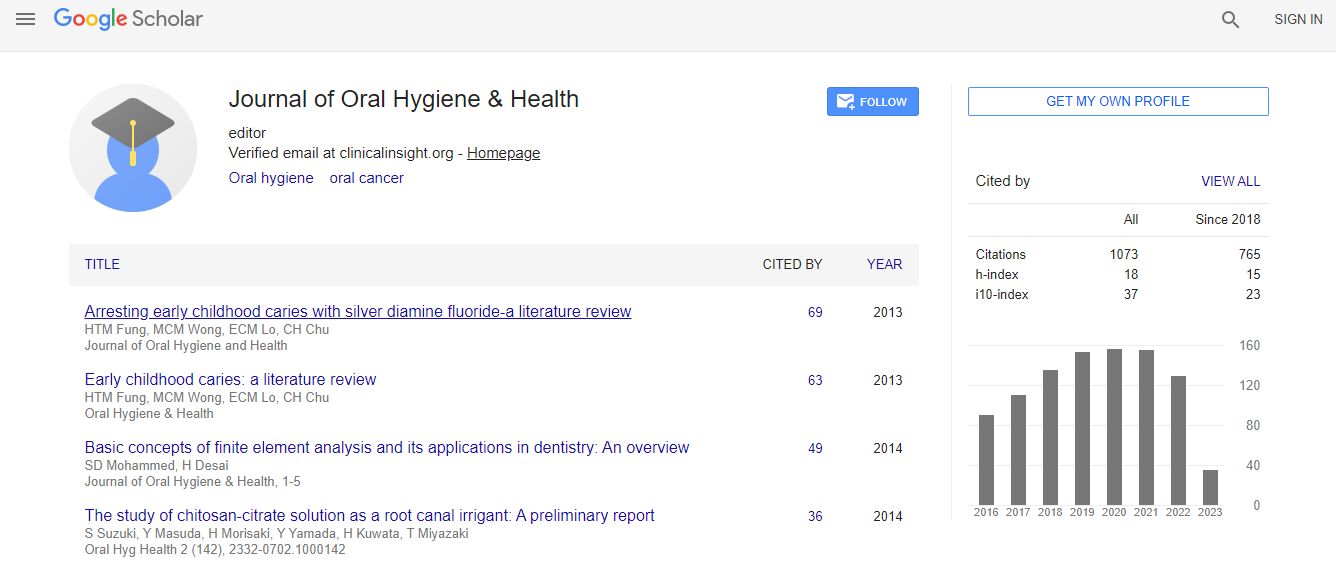Our Group organises 3000+ Global Conferenceseries Events every year across USA, Europe & Asia with support from 1000 more scientific Societies and Publishes 700+ Open Access Journals which contains over 50000 eminent personalities, reputed scientists as editorial board members.
Open Access Journals gaining more Readers and Citations
700 Journals and 15,000,000 Readers Each Journal is getting 25,000+ Readers
Google Scholar citation report
Citations : 1073
Journal of Oral Hygiene & Health received 1073 citations as per Google Scholar report
Journal of Oral Hygiene & Health peer review process verified at publons
Indexed In
- Index Copernicus
- Google Scholar
- Open J Gate
- JournalTOCs
- RefSeek
- Hamdard University
- EBSCO A-Z
- OCLC- WorldCat
- Publons
- Geneva Foundation for Medical Education and Research
- Euro Pub
- ICMJE
Useful Links
Recommended Journals
Related Subjects
Share This Page
Association between maxillary posterior segment discrepancy and the angulation of maxillary molars in patients with different vertical growth patterns
Annual Congress on Endodontics, Orthodontics, Prosthodontics and Dental Implants
Durr E Shahwar Malik
Aga Khan University, Pakistan
ScientificTracks Abstracts: J Oral Hyg Health
Abstract
Statement of the Problem: The impaction of maxillary third molars causes the crowns of maxillary first and second molars to tip distally in patients with maxillary posterior segment discrepancy. The aim of this study was to compare the maxillary first and second molar angulations in patients with Maxillary Posterior Segment Discrepancy (MPSD) with Non-Maxillary Posterior Segment Discrepancy (N-MPSD) and evaluate the effect of their angulations on various divergence patterns. Materials & Method: A cross-sectional study was conducted using the pre-treatment lateral cephalograms of 180 subjects which were divided into two groups i.e. MPSD and N-MPSD. The Mann-Whitney U test was applied to compare various skeletal and dental parameters between the two groups and a pairwise comparison was made among the vertical growth patterns. The Kruskal Wallis test was used to compare the mean molar angulations and overbite among the three divergence patterns. Result: The ratio of anterior to total palatal plane (p≤0.001) and the molar angulation (p≤0.001) showed significant differences between the MPSD and N-MPSD groups. In the MPSD group, significant differences were found between the overbite in the normodivergent versus hyperdivergent (p≤0.001) and hypodivergent versus hyperdivergent groups (p≤0.001) and in the angulation of the first maxillary molars in the normodivergent versus hyperdivergent groups (p≤0.001). Conclusion & Significance: MPSD causes reduced maxillary first and second molar angulations. A ratio of the anterior palatal plane to total palatal plane length of ≥0.51 was seen in patients with impacted maxillary third molars.Biography
Durr E Shahwar Malik is the resident at the Orthodontics Department of the Aga Khan University Hospital, Pakistan.
E-mail: dmalik.bangash@gmail.com

 Spanish
Spanish  Chinese
Chinese  Russian
Russian  German
German  French
French  Japanese
Japanese  Portuguese
Portuguese  Hindi
Hindi 
